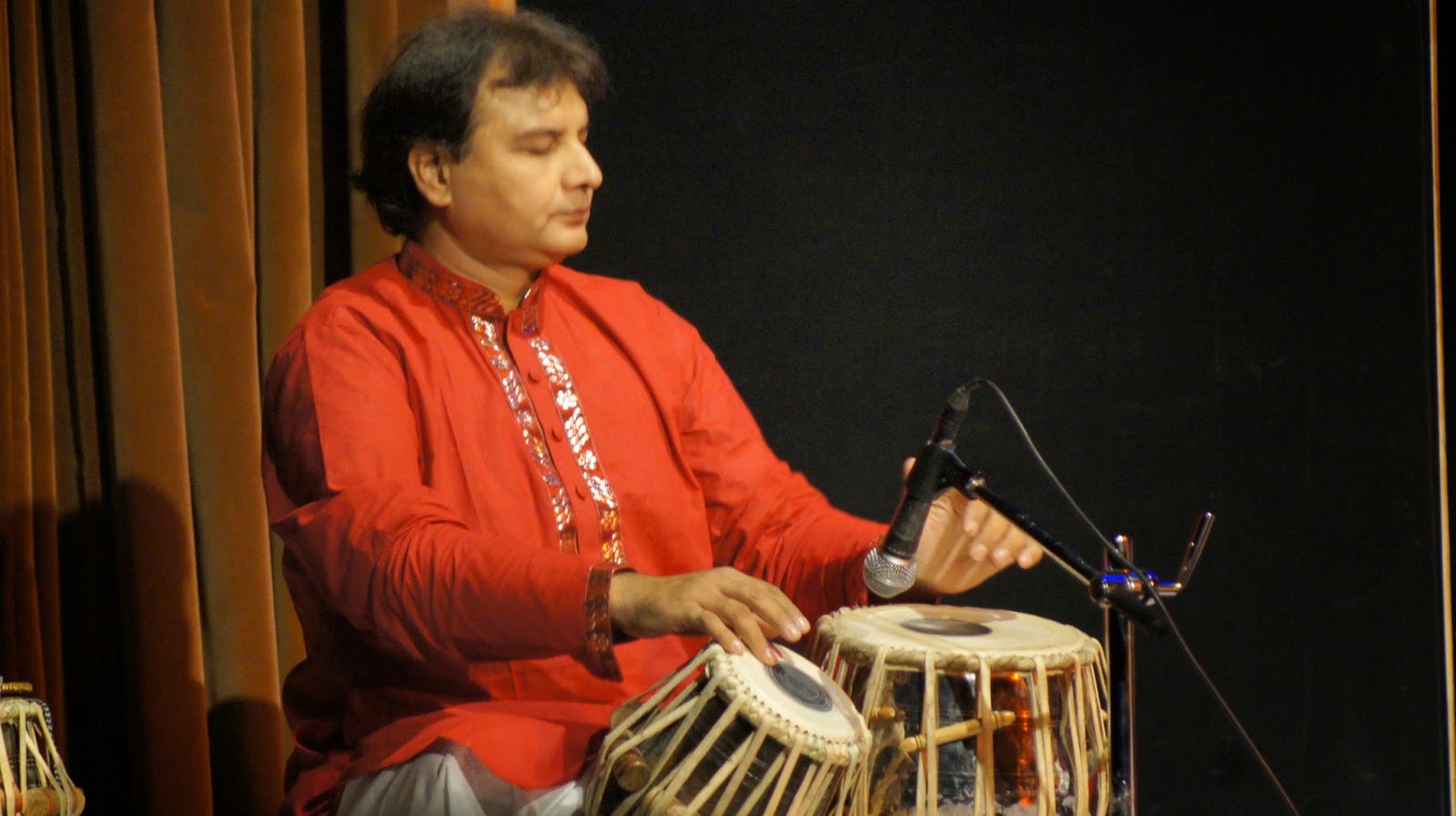A satrangi performance
Last month,
‘7 essence’ was held at the IHC in Delhi. It was about seven artists sharing
the stage with equal potential and complimenting each other. The evening
started with felicitations of the chief guests, Sabir Ali Khan and Hashmat Ali
Khan, Manjari Sahay and Satish Mehta from the ICCR.
The seven
essences or the seven artists had their talents spread across different musical
instruments and dance. The instruments involved blowing, bowing, plucking and
strokes. Pt. Roopak Kulkarni on flute is the son and disciple of late Pt Malhar
Rao Kulkarni. He has trained under Pt Hariprasad Chaurasia to become an
outstanding exponent of Maihar gharana. He has performed extensively.
 |
| Akram Khan |
Akram Khan
on tabla has been trained under his great grandfather Ustad Mohd. Shafi Khan
and continues his training under the guidance of his father Ustad Hashmat Ali
Khan. He is a top grade artist from AIR and an empanelled artist of ICCR. He
has performed in India and abroad.
 |
| Murad Ali Khan |
The third performer, Murad Ali Khan on sarangi,
is the sixth generation sarangi player from the Moradabad tradition. He trained
under his grandfather and his father Ustad Ghulam Sabir Khan. He has won
several awards - Sarangi Ratna and Sanskriti award, to name a few. He is
empanelled with ICCR and has frequently performed in India and abroad.
 |
| Fateh Ali Khan |
Fateh
Ali Khan on sitar was initiated to the instrument by Shri Satish Kumarji and
later trained under Ustad Shamsuddin Faridi Desai. He is an empanelled artist
of ICCR. Fateh has been doing various contemporary and classical music albums
with international musicians. Nupur Shankar on vocals and padhant has trained under
Pt Birju Maharaj in thumri. Shuheb Hasan on vocals has been trained by legendary vocalist Ustad Siddique Ahmed Khan and Ustad Ghulam Sabir Khan. He has performed at many
festivals and accompanied many Kathak stalwarts.
 |
| Shuheb Hasan |
 |
| Mahua Shanker |
 |
| Nupur Shanker |
Nupur
Shankar, like a sutradhar in theatre, introduced each artist, their profile and
their art. She went to the extent of explaining the number of strings and the
material used in their making. Kathak, she said, originated from the Sanskrit
word katha. It has its beginning in the temples of North India as a means of
worship and telling mythological tales. It went on to be performed in the havelis
and royal courts of the Mughals.
The first to
take the stage were Murad Ali, Fateh Ali and Akram Khan. The trio played a composition
in Raag Shyam Kalyan. The melody of the three instruments, with the soulful
music of sarangi and the vibrancy of sitar and tabla, created a piece seeping
through the soul during its ascent and descent.
Mahua
Shankar began her performance with a bhajan, ‘Mharo pranam banke Behariji’, a
nritya piece. Krishna is shown to wear a mormukut (a crown of peacock
feathers), a tilak on his forehead and having black curls. The bhakta weaves a
garland to pay his obeisance. ‘Mor mukut maathe tilak viraaje, ghunghar alka
kaliji. He plays on the flute to entice the gopis – ‘adhar madhur bansi bajai,
rijh rijhai brij nari ji’.
.JPG) |
| Mahua Shanker |
Next, she
did nritta in taal rupak, a throwing of the dice with the rhythm, tukda,
permelu – one friend ‘sust’ or dull and one friend ‘chust’ or smart. This was
an interesting piece as the parhant took two different speeds. This was
followed by a paran and tihai, which was the swaying gait of a girl that
matched the manner of recitation. She finished with a paran with 25 pirouettes.
This was followed by a thumri, a composition of Amir Khusro, ‘A ri sakhi mere
piya ghar aaye’. The nayika is portrayed as decking herself up and adorning her
bed with flowers to welcome her beloved.
Then, in
the true tradition of Birju Maharaj, she performed tukdas in teen taal, imbuing
each rhythm with meaning. Patang Katna (the thread of a kite being snipped),
the movement of the kite flying, swaying and falling to the ground was shown
with the recitation and hand movements. The mannerisms of three animals – a
cow, a deer and a lion - were shown by the speed and tone of the padhant, followed by a tihai to show the
suddenness of encountering somebody.
Akram khan
and Mahua with the bol, footwork and beats created a conversation and coming
together of two friends. She did a phool ki gat, the blooming flowers are
plucked and strung together in a sting to form a gajra for the hair. She
concluded with a tukda with 21 pirouettes. Mahua’s nritta and nritya were very
well defined, with exactitude in footwork and hastas. She exuberated confidence
and beauty .
 |
| Pt Roopak Kulkarni |
The next
essence or artist to take the stage was Pt Roopak Kulkarni. He played a piece
in raag maru behaag. It was a very melodious composition, transporting the
audience to a different realm. Finally, they all came together for a jog tarana
piece which I sadly missed. I wish they’d shortened the performance somewhat!
Note: This article first appeared in narthaki.com
Pics: Anoop Arora


Comments
Post a Comment